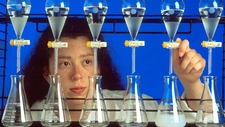Measurement

TEKS Objective
Collect information by detailed observations and accurate measuring.
Essential Understanding
The student uses scientific methods during laboratory and outdoor investigations.
Science Background
The Metric System, Metric and Scientific Notation: Visionlearning (website) - Information about the history, unit measures and notation of the metric system.
Scientific Measurements: Chymist.com (PDF) - Brief history of measurement and human civilization, and an overview of the International System of Units.
Scientific Measurements
by David A. Katz, www.chymist.com
Temperature Scales: School for Champions (website) - Overview of temperature scales and how to convert from one scale to another (e.g., Fahrenheit to Celsius).
Temperature Scales
by Ron Kurtus, School for Champions, www.school-for-champions.com
Signature Lesson
Metric Madness: K8 Science (PDF) - Students use tools to collect information, and apply the skills of estimation and metric measurements as they rotate through stations or centers in groups.
- Supporting Lessons
- Extensions
- Assessment Ideas
- Literature Connections
- Related
TEKS - Additional Resources
Supporting Lessons
Measure Your Pulse with a Straw: Education.com (website) - Students construct and use a simple device with which to observe and measure their pulse.
Measure Your Pulse with a Straw
by Alexandra Blickley, Education.com
Metric Mania Lesson Plans: The Science Spot (website) - Series of lessons/labs on metric length, mass, volume, density, and temperature, as well as metric-to-metric and metric-to-English conversions. Students collect information, make detailed observations, and take accurate measurements with rulers, triple-beam balances, and other science equipment.
Metric Mania Lesson Plans
The Science Spot, www.sciencespot.net
Elaboration Lessons and Extensions
Naturalist Journals: BioEd Online (website) - Teacher guide covering the uses and benefits of naturalist journals, which for centuries have helped scientists organize sketches, pictures and written observations.
Naturalist Journals
BioEd Online, www.bioedonline.org
Build Your Own Barometer: Education.com (website) - Make a device to measure, record and compare different air and weather conditions.
Assessment Ideas
Use the evaluation from Metric Mania (see Supporting Lessons, above) to assess students’ knowledge of metric measurements and conversions.
Metric Mania Assessment
The Science Spot, www.sciencespot.net
Literature Connections
What’s the Plan? Designing Your Experiment. Hyde, Natalie (ISBN-13: 978-0778751540)
Solving Science Questions: A Book About the Scientific Process. Chappell, Rachel M. (ISBN-13: 978-1600445422)
Additional Resources
Tips to Educators for Teaching the Metric System: US Metric Association (website) - General principles for teaching the metric system, ideas for acquainting students with metric units, and suggested in-depth, metric-focused learning activities in a variety of subjects.
Tips to Educators for Teaching the Metric System
US Metric Association, www.metric.org
Metrics Matter: ThinkQuest (website) - The metric system is used worldwide in business and science. Explore this site for information about metric measures of length, volume and mass; global systems for measuring temperature and keeping time; and conversions between systems.
TEKS Navigation
Grade 5
Need Assistance?
If you need help or have a question please use the links below to help resolve your problem.

Comments